Reading Paintings As a Window on Worldview
In ArtAchieve's art lessons for kids, we remind the students that:
-
There is no right or wrong way to draw.
-
One drawing is not better than another. It’s just different—because the people who are drawing them are different.
That’s good advice for kids. It’s a way of steering them away from perfectionism, from thinking that their art work has to be a photographic replication of the thing they are drawing.
Realizing that the art you create is going to look different from that created by your neighbor, simply because you are different from your neighbor helps to silence the internal critic that can destroy a child’s ability to learn to make art.
However, that’s only half of the story.
Throughout the history of art, the artists have distorted the way things look. We often recognize their art because we’ve learned to recognize their type of distortions.
-
Picasso, for example, often painted faces that looked in two directions
|

|
|
"Untitled." Public Domain. http://www.wikiart.org/
|
-
Van Gogh painted buildings, trees, and people using rough brushstrokes and contorted lines
|
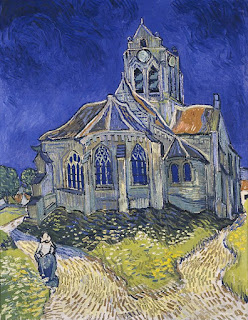
|
|
The_Church at Auvers. Public Domain. (https://en.wikipedia.org/wiki/The_Church_at_Auvers)
|
-
Early Christian artists painted icons that make people look flat and somewhat other-worldly. This mosaic, for example, shows the Emperor Justinian and Bishop Maximian of Ravenna surrounded by clerics and soldiers
|

|
|
Mosaic from San Vitale in Ravenna. Public Domain. (https://en.wikipedia.org/wiki/Byzantine_art)
|
The important point, however, is NOT that these artists just had quirky styles. That would only make us wonder or roll our eyes as we view their work and the way they distorted objects.
The important thing is that they distorted what they saw to communicate big ideas--the important ideas of their times.
Over time, people thought these artists had captured the ideas of their time so well that their paintings, drawings, or sculptures became images that have also come to represent the ideas of the time.
Painting As an Introduction To the Enlightenment
Let’s use Thomas Gainsborough, who lived in England from 1727 to 1788. His paintings capture the ideas of the Enlightenment, of thinkers like René Descartes.
|
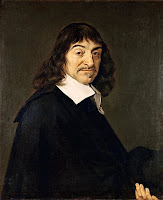
|
|
René Descartes. https://en.wikipedia.org/wiki/Ren%C3%A9_Descartes
|
|
Here are some of the Enlightenment ideas:
-
The world operates like a great big machine.
-
God is like a clock-maker, who put the world/machine together, wound it up, and set it ticking.
-
People can learn to dominate and use the machine by learning how the "clock" (the world) works.
-
Science can give us the tools for such domination.
If you'd like to learn more about Decartes' ideas and would like to discuss them, click here.
How Thomas Gainsborough Captured the Ideas of the Enlightenment.
How does Gainsborough capture the ideas of the Enlightenment? You can find several of his paintings in Bath, England’s Holburne Museum, where we visited recently. Happily for us, it's ok to take photographs in the museum!
Here is his painting of The Byam Family.
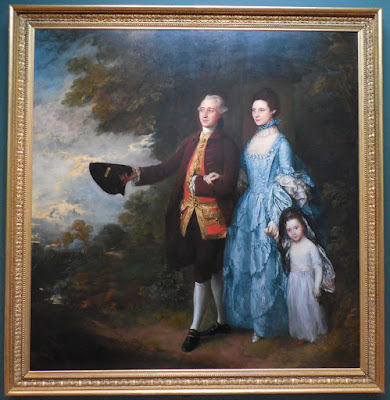
How does this painting capture the ideas of the enlightenment? What does Gainsborough want us to notice? After you notice the details pointed out in the list below, you'll probably find even more telling details!
-
The figures show us that nature is their property. Notice now that man gestures, as though to say, “Let me introduce you to my world.”
-
The figures are regally dressed. Their stance is authoritative. Their pose is that of royalty.
-
The figures are confident and proud. Nature and the world around them cannot disturb them. They are in control.
Now study another Gainsborough painting that hangs in the museum.
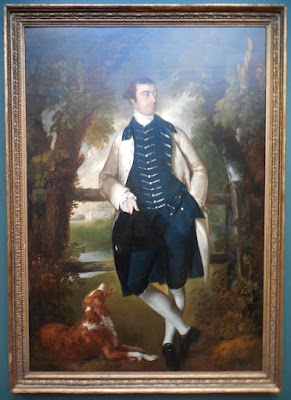
-
Look carefully and you can see that the trees make a pointed arch to frame the man. Where have you seen that shape before? These trees make an arch shaped like the frame of a cathedral window. Is Gainsborough suggesting that we should look up to this confident man as a kind of saint?
-
His dog looks up to him, waiting to serve. How will he help the man dominate his world? Will he help with hunting? With herding flocks?
-
The man leans on a fence, and his glance shows he is expecting good things to come his way.
-
Behind him is a wealthy property, well-managed, manicured, and tamed.
In both cases, the painting show that mankind is easily able to have dominion over the world.
Art isn’t just for decoration. It can also help us understand the painter’s worldview.
Art and Positivism
When we lived in Ukraine in 1995, we were considered fortunate: we lived in a khrushchyovka!

Khrushchyovkas are apartment houses, and they were built all over the Soviet Union under Premiere Nikita Krushchev’s leadership. When they were built, Russians considered them luxurious.
Here’s why.

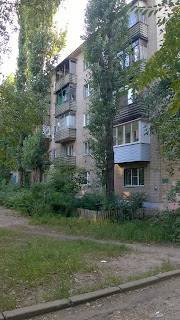
During WWII, Soviet cities were devastated by the German army. Many people lived in dirt-floored shacks. Others found themselves in cramped apartments where families had a bedroom, but shared a kitchen with several other families.
So imagine how wonderful a Krushchev era khrushchyovka must have seemed. Our apartment had its own 65 sq. ft. kitchen, and its own bathroom, living room, and bedroom - 646 sq. ft. in all. The only thing we had to share with our neighbors was the entrance hallway and the locking door that led to it!
Khrushchyovkas were prefabricated. Panels made at concrete plants were trucked to sites as needed, so housing went up quickly.
But there was a downside.
Every khrushchyovka had - and has - the same floor plan. In other words, the khrushchyovka in Kharkiv, Ukraine looks like a khrushchyovka in Moscow, or St. Petersburg, or wherever. Imagine a neighborhood of khrushchyovkas. Every building looks the same as the one next to it. Every building has the same - often concrete grey - color. All of them are unornamented. Cities all over the Soviet Union had similar neighborhoods.
A common way to celebrate New Year's Eve in former Soviet cities is to watch the movie, Irony of Fate. In it, a Moscow-dweller mistakenly flies to Leningrad; the taxicab drives him to his home street address (which happens to exist in Leningrad as well), and the building and the apartment - and even the key to the apartment - are exactly the same as his own. He enters what seems to be his own apartment (using his own Moscow key!), and the fun begins when the real owner arrives.
What do khrushchyovkas have to do with worldview?
The khrushchyovka was built as part of a Soviet system that saw people functionally - as workers. Murals on buildings showed machine-like, dehumanized workers laboring at some task. People were valued less as individuals than as working contributors to the Soviet machine. Why would such cogs in the Soviet machine need homes that showed some individual flare?
The khrushchyovkas were not really a Soviet invention, however. Krushchev merely borrowed from Germany's Bauhaus to design the new apartments, and the Bauhaus got its ideas from positivism.
What is positivism?
Positivists believe that all truth could be found through science. Anything that is not scientific is regarded as worthless. Art is unimportant, as are literature, and religion.
When I was teaching creative dramatics to teachers in Ukraine, my supervisor told me I had to teach them scientific methodology. Even drama games had to be reduced to science to be valid.
Positivist thought would be like the scientist who goes to a beautiful symphony concert, and his only response is to ask, “How much do musicians earn?” He can value the music only if he can find a mathematical/scientific way to measure it.
I guess that’s one reason we get excited about teaching art. It’s one reminder that there’s more to the world than facts. There is also beauty. And beauty provides its own kind of meaning.
Use a free art lesson to make a little beauty of your own!
In ArtAchieve's art lessons for kids, we remind the students that:
-
There is no right or wrong way to draw.
-
One drawing is not better than another. It’s just different—because the people who are drawing them are different.
That’s good advice for kids. It’s a way of steering them away from perfectionism, from thinking that their art work has to be a photographic replication of the thing they are drawing.
Realizing that the art you create is going to look different from that created by your neighbor, simply because you are different from your neighbor helps to silence the internal critic that can destroy a child’s ability to learn to make art.
However, that’s only half of the story.
Throughout the history of art, the artists have distorted the way things look. We often recognize their art because we’ve learned to recognize their type of distortions.
-
Picasso, for example, often painted faces that looked in two directions
|

|
|
"Untitled." Public Domain. http://www.wikiart.org/
|
-
Van Gogh painted buildings, trees, and people using rough brushstrokes and contorted lines
|

|
|
The_Church at Auvers. Public Domain. (https://en.wikipedia.org/wiki/The_Church_at_Auvers)
|
-
Early Christian artists painted icons that make people look flat and somewhat other-worldly. This mosaic, for example, shows the Emperor Justinian and Bishop Maximian of Ravenna surrounded by clerics and soldiers
|

|
|
Mosaic from San Vitale in Ravenna. Public Domain. (https://en.wikipedia.org/wiki/Byzantine_art)
|
The important point, however, is NOT that these artists just had quirky styles. That would only make us wonder or roll our eyes as we view their work and the way they distorted objects.
The important thing is that they distorted what they saw to communicate big ideas--the important ideas of their times.
Over time, people thought these artists had captured the ideas of their time so well that their paintings, drawings, or sculptures became images that have also come to represent the ideas of the time.
Painting As an Introduction To the Enlightenment
Let’s use Thomas Gainsborough, who lived in England from 1727 to 1788. His paintings capture the ideas of the Enlightenment, of thinkers like René Descartes.
|

|
|
René Descartes. https://en.wikipedia.org/wiki/Ren%C3%A9_Descartes
|
|
Here are some of the Enlightenment ideas:
-
The world operates like a great big machine.
-
God is like a clock-maker, who put the world/machine together, wound it up, and set it ticking.
-
People can learn to dominate and use the machine by learning how the "clock" (the world) works.
-
Science can give us the tools for such domination.
If you'd like to learn more about Decartes' ideas and would like to discuss them, click here.
How Thomas Gainsborough Captured the Ideas of the Enlightenment.
How does Gainsborough capture the ideas of the Enlightenment? You can find several of his paintings in Bath, England’s Holburne Museum, where we visited recently. Happily for us, it's ok to take photographs in the museum!
Here is his painting of The Byam Family.

How does this painting capture the ideas of the enlightenment? What does Gainsborough want us to notice? After you notice the details pointed out in the list below, you'll probably find even more telling details!
-
The figures show us that nature is their property. Notice now that man gestures, as though to say, “Let me introduce you to my world.”
-
The figures are regally dressed. Their stance is authoritative. Their pose is that of royalty.
-
The figures are confident and proud. Nature and the world around them cannot disturb them. They are in control.
Now study another Gainsborough painting that hangs in the museum.

-
Look carefully and you can see that the trees make a pointed arch to frame the man. Where have you seen that shape before? These trees make an arch shaped like the frame of a cathedral window. Is Gainsborough suggesting that we should look up to this confident man as a kind of saint?
-
His dog looks up to him, waiting to serve. How will he help the man dominate his world? Will he help with hunting? With herding flocks?
-
The man leans on a fence, and his glance shows he is expecting good things to come his way.
-
Behind him is a wealthy property, well-managed, manicured, and tamed.
In both cases, the painting show that mankind is easily able to have dominion over the world.
Art isn’t just for decoration. It can also help us understand the painter’s worldview.
Art and Positivism
When we lived in Ukraine in 1995, we were considered fortunate: we lived in a khrushchyovka!

Khrushchyovkas are apartment houses, and they were built all over the Soviet Union under Premiere Nikita Krushchev’s leadership. When they were built, Russians considered them luxurious.
Here’s why.


During WWII, Soviet cities were devastated by the German army. Many people lived in dirt-floored shacks. Others found themselves in cramped apartments where families had a bedroom, but shared a kitchen with several other families.
So imagine how wonderful a Krushchev era khrushchyovka must have seemed. Our apartment had its own 65 sq. ft. kitchen, and its own bathroom, living room, and bedroom - 646 sq. ft. in all. The only thing we had to share with our neighbors was the entrance hallway and the locking door that led to it!
Khrushchyovkas were prefabricated. Panels made at concrete plants were trucked to sites as needed, so housing went up quickly.
But there was a downside.
Every khrushchyovka had - and has - the same floor plan. In other words, the khrushchyovka in Kharkiv, Ukraine looks like a khrushchyovka in Moscow, or St. Petersburg, or wherever. Imagine a neighborhood of khrushchyovkas. Every building looks the same as the one next to it. Every building has the same - often concrete grey - color. All of them are unornamented. Cities all over the Soviet Union had similar neighborhoods.
A common way to celebrate New Year's Eve in former Soviet cities is to watch the movie, Irony of Fate. In it, a Moscow-dweller mistakenly flies to Leningrad; the taxicab drives him to his home street address (which happens to exist in Leningrad as well), and the building and the apartment - and even the key to the apartment - are exactly the same as his own. He enters what seems to be his own apartment (using his own Moscow key!), and the fun begins when the real owner arrives.
What do khrushchyovkas have to do with worldview?
The khrushchyovka was built as part of a Soviet system that saw people functionally - as workers. Murals on buildings showed machine-like, dehumanized workers laboring at some task. People were valued less as individuals than as working contributors to the Soviet machine. Why would such cogs in the Soviet machine need homes that showed some individual flare?
The khrushchyovkas were not really a Soviet invention, however. Krushchev merely borrowed from Germany's Bauhaus to design the new apartments, and the Bauhaus got its ideas from positivism.
What is positivism?
Positivists believe that all truth could be found through science. Anything that is not scientific is regarded as worthless. Art is unimportant, as are literature, and religion.
When I was teaching creative dramatics to teachers in Ukraine, my supervisor told me I had to teach them scientific methodology. Even drama games had to be reduced to science to be valid.
Positivist thought would be like the scientist who goes to a beautiful symphony concert, and his only response is to ask, “How much do musicians earn?” He can value the music only if he can find a mathematical/scientific way to measure it.
I guess that’s one reason we get excited about teaching art. It’s one reminder that there’s more to the world than facts. There is also beauty. And beauty provides its own kind of meaning.
Use a free art lesson to make a little beauty of your own!
In ArtAchieve's art lessons for kids, we remind the students that:
-
There is no right or wrong way to draw.
-
One drawing is not better than another. It’s just different—because the people who are drawing them are different.
That’s good advice for kids. It’s a way of steering them away from perfectionism, from thinking that their art work has to be a photographic replication of the thing they are drawing.
Realizing that the art you create is going to look different from that created by your neighbor, simply because you are different from your neighbor helps to silence the internal critic that can destroy a child’s ability to learn to make art.
However, that’s only half of the story.
Throughout the history of art, the artists have distorted the way things look. We often recognize their art because we’ve learned to recognize their type of distortions.
-
Picasso, for example, often painted faces that looked in two directions
|

|
|
"Untitled." Public Domain. http://www.wikiart.org/
|
-
Van Gogh painted buildings, trees, and people using rough brushstrokes and contorted lines
|

|
|
The_Church at Auvers. Public Domain. (https://en.wikipedia.org/wiki/The_Church_at_Auvers)
|
-
Early Christian artists painted icons that make people look flat and somewhat other-worldly. This mosaic, for example, shows the Emperor Justinian and Bishop Maximian of Ravenna surrounded by clerics and soldiers
|

|
|
Mosaic from San Vitale in Ravenna. Public Domain. (https://en.wikipedia.org/wiki/Byzantine_art)
|
The important point, however, is NOT that these artists just had quirky styles. That would only make us wonder or roll our eyes as we view their work and the way they distorted objects.
The important thing is that they distorted what they saw to communicate big ideas--the important ideas of their times.
Over time, people thought these artists had captured the ideas of their time so well that their paintings, drawings, or sculptures became images that have also come to represent the ideas of the time.
Painting As an Introduction To the Enlightenment
Let’s use Thomas Gainsborough, who lived in England from 1727 to 1788. His paintings capture the ideas of the Enlightenment, of thinkers like René Descartes.
|

|
|
René Descartes. https://en.wikipedia.org/wiki/Ren%C3%A9_Descartes
|
|
Here are some of the Enlightenment ideas:
-
The world operates like a great big machine.
-
God is like a clock-maker, who put the world/machine together, wound it up, and set it ticking.
-
People can learn to dominate and use the machine by learning how the "clock" (the world) works.
-
Science can give us the tools for such domination.
If you'd like to learn more about Decartes' ideas and would like to discuss them, click here.
How Thomas Gainsborough Captured the Ideas of the Enlightenment.
How does Gainsborough capture the ideas of the Enlightenment? You can find several of his paintings in Bath, England’s Holburne Museum, where we visited recently. Happily for us, it's ok to take photographs in the museum!
Here is his painting of The Byam Family.

How does this painting capture the ideas of the enlightenment? What does Gainsborough want us to notice? After you notice the details pointed out in the list below, you'll probably find even more telling details!
-
The figures show us that nature is their property. Notice now that man gestures, as though to say, “Let me introduce you to my world.”
-
The figures are regally dressed. Their stance is authoritative. Their pose is that of royalty.
-
The figures are confident and proud. Nature and the world around them cannot disturb them. They are in control.
Now study another Gainsborough painting that hangs in the museum.

-
Look carefully and you can see that the trees make a pointed arch to frame the man. Where have you seen that shape before? These trees make an arch shaped like the frame of a cathedral window. Is Gainsborough suggesting that we should look up to this confident man as a kind of saint?
-
His dog looks up to him, waiting to serve. How will he help the man dominate his world? Will he help with hunting? With herding flocks?
-
The man leans on a fence, and his glance shows he is expecting good things to come his way.
-
Behind him is a wealthy property, well-managed, manicured, and tamed.
In both cases, the painting show that mankind is easily able to have dominion over the world.
Art isn’t just for decoration. It can also help us understand the painter’s worldview.
Art and Positivism
When we lived in Ukraine in 1995, we were considered fortunate: we lived in a khrushchyovka!

Khrushchyovkas are apartment houses, and they were built all over the Soviet Union under Premiere Nikita Krushchev’s leadership. When they were built, Russians considered them luxurious.
Here’s why.


During WWII, Soviet cities were devastated by the German army. Many people lived in dirt-floored shacks. Others found themselves in cramped apartments where families had a bedroom, but shared a kitchen with several other families.
So imagine how wonderful a Krushchev era khrushchyovka must have seemed. Our apartment had its own 65 sq. ft. kitchen, and its own bathroom, living room, and bedroom - 646 sq. ft. in all. The only thing we had to share with our neighbors was the entrance hallway and the locking door that led to it!
Khrushchyovkas were prefabricated. Panels made at concrete plants were trucked to sites as needed, so housing went up quickly.
But there was a downside.
Every khrushchyovka had - and has - the same floor plan. In other words, the khrushchyovka in Kharkiv, Ukraine looks like a khrushchyovka in Moscow, or St. Petersburg, or wherever. Imagine a neighborhood of khrushchyovkas. Every building looks the same as the one next to it. Every building has the same - often concrete grey - color. All of them are unornamented. Cities all over the Soviet Union had similar neighborhoods.
A common way to celebrate New Year's Eve in former Soviet cities is to watch the movie, Irony of Fate. In it, a Moscow-dweller mistakenly flies to Leningrad; the taxicab drives him to his home street address (which happens to exist in Leningrad as well), and the building and the apartment - and even the key to the apartment - are exactly the same as his own. He enters what seems to be his own apartment (using his own Moscow key!), and the fun begins when the real owner arrives.
What do khrushchyovkas have to do with worldview?
The khrushchyovka was built as part of a Soviet system that saw people functionally - as workers. Murals on buildings showed machine-like, dehumanized workers laboring at some task. People were valued less as individuals than as working contributors to the Soviet machine. Why would such cogs in the Soviet machine need homes that showed some individual flare?
The khrushchyovkas were not really a Soviet invention, however. Krushchev merely borrowed from Germany's Bauhaus to design the new apartments, and the Bauhaus got its ideas from positivism.
What is positivism?
Positivists believe that all truth could be found through science. Anything that is not scientific is regarded as worthless. Art is unimportant, as are literature, and religion.
When I was teaching creative dramatics to teachers in Ukraine, my supervisor told me I had to teach them scientific methodology. Even drama games had to be reduced to science to be valid.
Positivist thought would be like the scientist who goes to a beautiful symphony concert, and his only response is to ask, “How much do musicians earn?” He can value the music only if he can find a mathematical/scientific way to measure it.
I guess that’s one reason we get excited about teaching art. It’s one reminder that there’s more to the world than facts. There is also beauty. And beauty provides its own kind of meaning.
Use a free art lesson to make a little beauty of your own!







